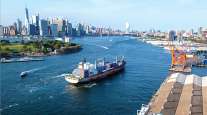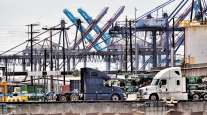Ports of Los Angeles, Long Beach, Oakland Shatter Records

All three major containerports in California reported record-setting volumes in July, prompting an industry consultant to forecast the summer of 2017 one of the best peak retail shipping seasons in U.S. history.
The No. 1 port — Los Angeles — set a record last month with 796,804 industry-standard 20-foot-equivalent units (TEUs), up 16% compared with July 2016. Loaded container imports increased 13% to 417,090, and loaded exports rose 17% to 154,925.
In commenting on the results, Port of Los Angeles Executive Director Gene Seroka congratulated the International Longshore and Warehouse Union and Pacific Maritime Association on a three-year extension of the collective bargaining agreement to 2022.
“The certainty that comes from this decision builds further long-term confidence in our supply chain as we continue to focus on superior infrastructure, innovative leadership and extraordinary customer service,” he said.
#PortofLA records busiest July in our history as container volumes jump 16%; 7 months into 2017, container volumes are 9.5% ahead of 2016. pic.twitter.com/hhzX0md7PB — Port of Los Angeles (@PortofLA) August 10, 2017
Through July, 2017 cargo volumes are 5.3 million TEUs, 9.5% higher than at the same time in 2016. Last year, Port of Los Angeles set a record for the Western Hemisphere with 8.9 million TEUs. Seroka recently told the American Journal of Transportation that he expects to shatter the record in 2017 with a 9% increase at the end of the year.
The Port of Long Beach — No. 2 — also set a record for the best month in its history with 720,312 TEUs in July, up 13% from one year ago. Year-over-year, cargo traffic has increased for five consecutive months in Long Beach and in six of the first seven months of 2017.
Loaded imports jumped 16% to 378,820, also setting an all-time record, although exports slipped 12% to 126,098.
July 2017 was the busiest month ever for the Port of Long Beach. Read more: https://t.co/637Do4GExO pic.twitter.com/yhEhSspnkf — Port of Long Beach (@portoflongbeach) August 11, 2017
“These numbers are great for Long Beach and good news for the economy,” Port of Long Beach Executive Director Mario Cordero said.
“Given the unprecedented change in the industry, we are pleased to see shippers choosing Long Beach,” Harbor Commission President Lou Anne Bynum said. “We thank our industry partners for having confidence in this port, and we pledge to continue to provide the best service and the best facilities.”
Volume is up 6.4% for the calendar year compared with 2016, although the data are somewhat skewed by Hanjin Shipping Co. having had difficulties leading up to its Aug. 31 bankruptcy protection filing, affecting traffic to its Total Terminals International complex.
The Port of Oakland — No. 9 — set an all-time record for loaded imports in July with 84,835 TEUs, up 5.4% year-over-year. Total volume equaled 209,883 TEUs, up from 206,600 last July, offsetting the 3.5% drop in loaded exports to 74,821.
“Retailers have been forecasting strong peak season import numbers this year, and so far, they’re right,” Port of Oakland Maritime Director John Driscoll said. “We’re glad to support them, and we are ready for more.”
@PortofOakland sets all-time record for #imports in a month https://t.co/jrJnUGuP9c #ports #oakland #containervolume pic.twitter.com/B1VU2Ao1aV — Port of Oakland (@PortofOakland) August 9, 2017
The port attributed the cargo increase to the economic health of its core market in Northern California and western Nevada.
The port reported that import volume through the first seven months of 2017 increased 3.7%, even though the number of vessels visiting Oakland during that period declined 7.6% because shipping lines are transporting more cargo on fewer but larger ships.
On the East Coast, the Port of Virginia — No. 5 — recorded a 7.5% increase in container traffic to 217,910. Loaded imports rose 9.1% to 100,106, but exports declined 1.9% to 77,174. Through July, total traffic was up 8.2% from 2016 to 1,495,990 TEUs.
Meanwhile, the monthly Global Port Tracker from the National Retail Federation and Hackett Associations predicts that August also will shatter records for imports on pace to a record year.
“Retailers are selling more, and that means they need to import more,” said Jonathan Gold, NRF vice president for supply chain and customs policy. “With sales showing year-over-year increases almost every month for a long time now, retail supply chains are working hard to keep up. These latest numbers are a good sign of what retailers expect in terms of consumer demand over the next few months.”
The July forecast called for a combined 1.72 million TEUs in loaded imports among the top ports in the United States, up 5.6% from the same time last year. August is forecast at 1.75 million, up 2.1% and what would be the highest monthly volume recorded since NRF began tracking imports in 2000, the federation reported.




